Archived Storm Damage Blog Posts
Rare February Storm Hits St. Cloud?
2/27/2024 (Permalink)
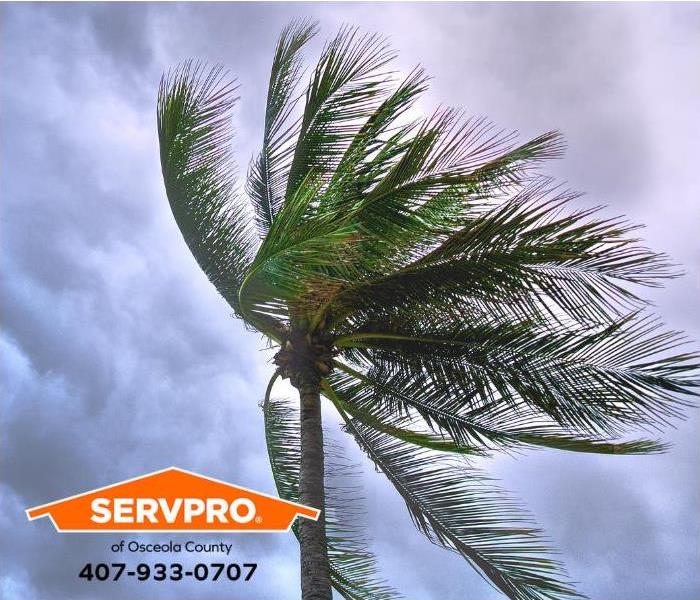 We restore storm damage 24 hours a day in Osceola County.
We restore storm damage 24 hours a day in Osceola County.
Our local Osceola County team is a trusted leader in storm damage restoration services. Although St. Cloud enjoys a relatively mild and pleasant climate during February, it can still be subject to a variety of weather conditions, including occasional storms. Here are some examples of the types of storms that can occur in February in Osceola County:
Thunderstorms: While severe thunderstorms are less common in February, the area can still experience occasional thunderstorms with lightning, heavy rain, and gusty winds.
Rainstorms: Rainfall is possible throughout the year in Osceola County, and February is no exception. Rainstorms can occur, but they are generally not as intense or frequent as during the summer months.
Cold fronts: February can bring occasional cold fronts, which may result in cooler temperatures and brisk winds. These fronts can sometimes lead to brief periods of unsettled weather.
Tornadoes: Although tornadoes are very rare in February in Florida, they are not impossible. While the risk is relatively low, staying informed about weather conditions and preparing for any severe weather event is essential.
Hailstorms: Hailstorms are infrequent in February, but hail can occasionally accompany thunderstorms or severe weather events.
Call Us Today!
When your home or commercial business in St. Cloud has storm damage, our local Osceola County team will restore the damage “Like it never even happened.” Call us today at 407-933-0707.
SERVPRO® franchises are independently owned and operated.
Rainstorm Causes Water Intrusion Issues in St. Cloud Home?
1/23/2024 (Permalink)
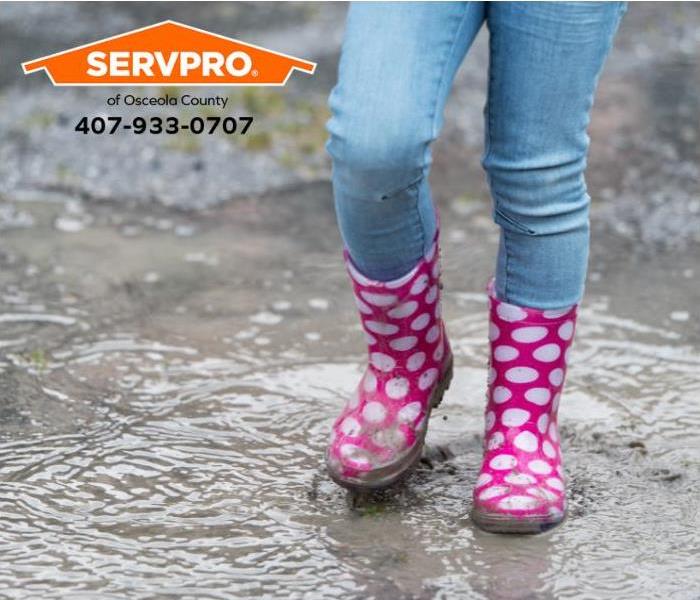 We respond to storm damage emergencies 24 hours a day in Osceola County.
We respond to storm damage emergencies 24 hours a day in Osceola County.
Our local Osceola County team is a leader in storm damage restoration services. St. Cloud averages 52 inches of rain each year, making it one of the rainiest cities in Florida. Water intrusion issues are a common challenge for residents, so here are some tips from the Insurance Information Institute to keep your home protected from unwanted water:
You can prevent water from entering your home by inspecting your home’s exterior for any place where water can enter the home and making repairs as needed.
- Caulk and seal windows.
- Inspect the roof for missing and aging shingles.
- Check your rain gutters and remove any debris that may be clogging them.
- Check your downspouts and clear any clogs and make sure they are draining away from the house.
- Gutter guards are a good way to prevent clogs and water intrusion into the house.
- Make sure water drains away from the building. After a storm, or when the ground is already saturated by rainwater, the water may enter into the foundation wall through any cracks.
Call Us Today!
When your home or commercial business in St. Cloud has a storm damage emergency, our local Osceola County team is Here to Help. ® We’ll restore your storm damage “Like it never even happened.” Call us today at 407-933-0707.
SERVPRO® franchises are independently owned and operated.
What Should I Do When My Property in Kissimmee Is Affected By Water Damage?
4/19/2023 (Permalink)
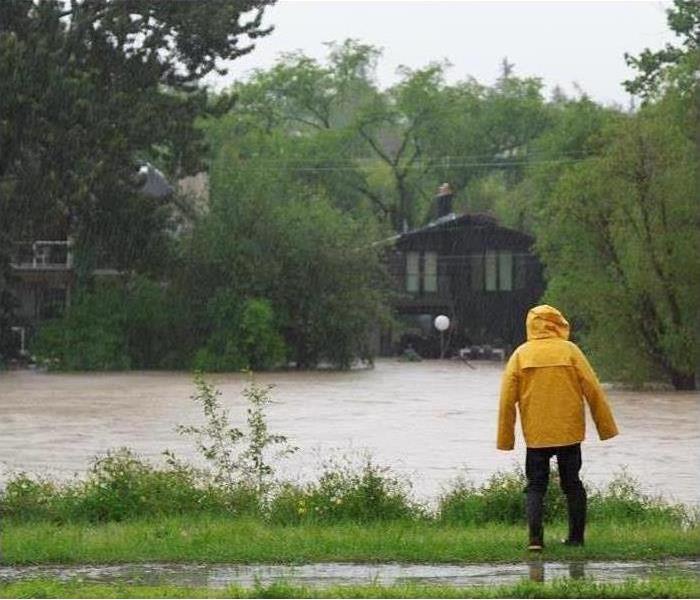 Excess River Water Threatens Flooding in Kissimmee Homes
Excess River Water Threatens Flooding in Kissimmee Homes
SERVPRO®: Restoring Your Kissimmee Home After Water Damage
Water damage in your Kissimmee home can be stressful, but taking immediate action is the key to minimizing the impact. When water infiltrates your property, it can quickly seep into structural elements, potentially causing extensive damage and fostering mold and mildew growth. Acting swiftly not only saves you time and money but also helps protect your cherished belongings.
At SERVPRO, we specialize in water damage restoration, offering a fast and reliable solution to get your home back to normal. Here's why addressing water damage promptly—and calling in the experts—matters:
Understanding Water Damage
Water damage can occur for a variety of reasons, from natural disasters like floods, hurricanes, or storms to household issues such as burst pipes or leaky appliances. Beyond visible damage, water intrusion can lead to:
- Poor air quality
- Mold and mildew growth
- High humidity levels
- Unpleasant odors that linger in walls, floors, and ceilings
- Damage to furniture, electronics, artwork, and personal possessions
To protect your home and belongings, it’s critical to start the water removal and cleanup process immediately. SERVPRO’s team is here to help.
Why Choose SERVPRO for Water Damage Restoration?
When water damage strikes, you need experienced professionals on your side. Here’s how SERVPRO can make a difference:
- Comprehensive Assessment: Our team conducts a thorough inspection to identify the extent of the damage, creating a customized restoration plan tailored to your needs.
- Rapid Response: SERVPRO’s specialists are ready to act quickly, deploying the resources needed to restore your property as fast as possible.
- Advanced Equipment: We use industry-leading tools like high-powered pumps, vacuums, air movers, and dehumidifiers to ensure every trace of moisture is eliminated.
The Drying Process: Essential for Restoration
After standing water is removed, proper drying is crucial to prevent further damage. With SERVPRO’s advanced equipment and techniques, we work to preserve your property by:
- Minimizing the need to replace hardwood floors, carpets, or walls.
- Preventing stains and odors caused by mold and mildew.
- Restoring your home to its pre-damage condition.
Acting quickly not only ensures a smoother restoration process but also minimizes long-term damage.
We’re Here When You Need Us Most
The moment water damage occurs, your first call should be to your insurance company—your second, to SERVPRO. Our highly trained team is available 24/7, providing emergency services to help restore your Kissimmee home “Like it never even happened.”
Locally Owned, Nationally Backed
SERVPRO of Osceola County is proud to be part of the Kissimmee community. As a locally owned and operated business, we understand the unique challenges our neighbors face and are committed to providing exceptional service.
We proudly serve Kissimmee, Osceola, and the surrounding areas. When you experience a water emergency, we’re just a phone call away.
Call Us Now for Fast, Reliable Water Damage Restoration
We’ll be at your door within an hour of your emergency. Don’t wait—call SERVPRO today.
How To Protect Your Commercial Roof From Storm Damage
3/24/2023 (Permalink)
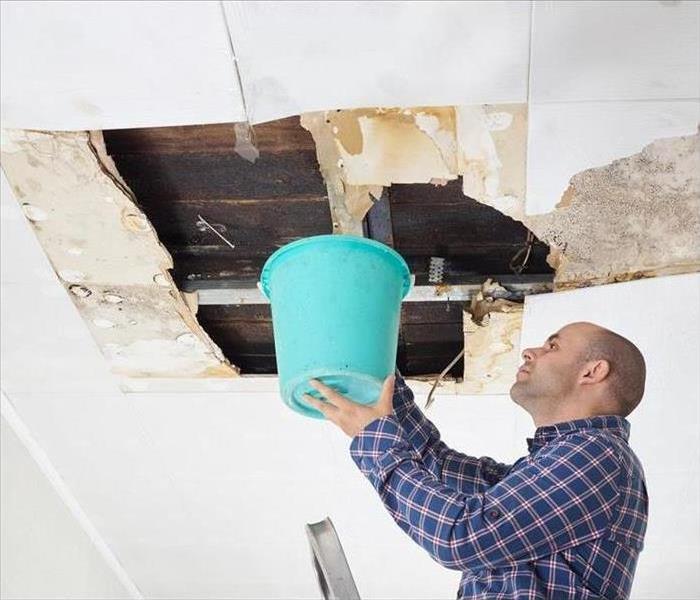 Water damage from a roof in Saint Cloud, FL
Water damage from a roof in Saint Cloud, FL
How to Prepare Your Saint Cloud, FL Business for a Storm: Protecting Your Roof
When a storm is headed toward Saint Cloud, FL, it’s essential to prepare your business to minimize potential damage. From strong winds to hail, storms bring numerous risks, particularly to your building's roof. By taking proactive steps, you can reduce roof damage and ensure your business stays operational after the storm. Here’s how:
1. Inspect Your Roof
Before the storm hits, conduct a thorough roof inspection to identify any existing issues that could worsen during severe weather. Look for:
- Leaks or signs of water damage
- Debris that could clog drainage systems
- Loose materials such as shingles or tiles
- Cracks or holes that need sealing
Address any damage or vulnerabilities immediately. Neglecting repairs can leave your roof more susceptible to storm damage.
2. Check Your AC Unit
If your air conditioning unit is roof-mounted, inspect it for proper functionality and security.
- Ensure the system is running smoothly.
- Verify that the unit and its metal panels are tightly secured to the roof to prevent damage from wind or debris.
Taking these precautions can protect both your roof and the AC unit during the storm.
3. Examine Perimeter Flashing
Perimeter flashing is a vital component of your roof's defense against wind and water. Inspect it closely for:
- Missing or loose sections
- Areas that don’t fit properly
Damaged flashing can lead to water intrusion and compromise your roof cover. Repair or replace any problematic flashing before the storm to help prevent leaks and water damage.
After the Storm: Act Quickly
Once the storm passes, inspect your roof again for any signs of damage, such as missing shingles, water pooling, or loose flashing. Address any issues immediately by contacting a professional. Delaying repairs can worsen the damage and lead to more costly restoration needs.
For significant storm damage, reach out to emergency restoration experts. They’ll assess the situation and guide you through the recovery process, ensuring your business can return to normal as quickly as possible.
By taking these proactive steps, you can protect your commercial roof and reduce the impact of severe weather on your business. Preparation is key to weathering the storm with minimal disruption.
What To Do When You Don't Have Flood Insurance
8/8/2022 (Permalink)
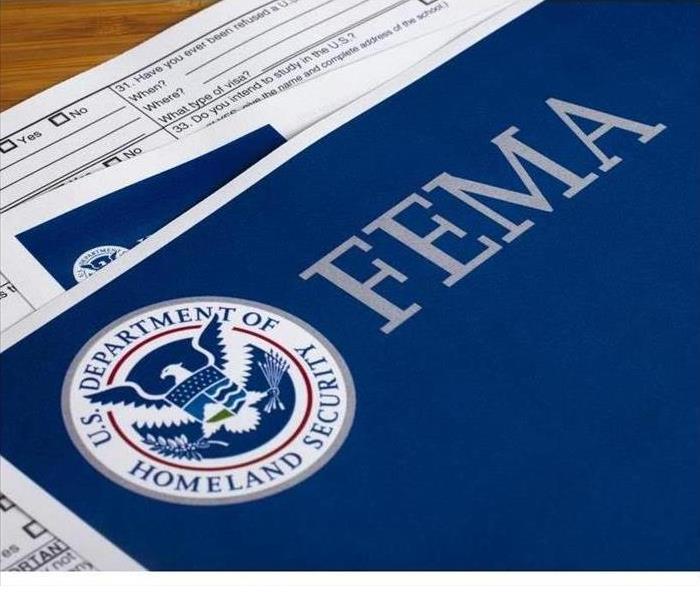 When your home has been affected by storm flooding you can apply through FEMA agency for some help
When your home has been affected by storm flooding you can apply through FEMA agency for some help
What To Do When You Don't Have Flood Insurance
When storms flood waters rushing into your home, there's not much time to do anything other than pack up your belongings and your family and move to a safe area. Eventually, however, you'll have to confront the costs of repairs. If you don't have flood insurance, you may feel at a loss regarding how to recover. If you live in an area where there's potential for flooding, you should consider getting a policy that covers:
- Contents of your home
- Repairs, reconstruction, or replacement of your home
- Temporary housing
Make sure you discuss the many things that insurance won't cover, such as items in the basement and swimming pools. If you don't have insurance, however, there are some steps you can take.
Financial Assistance
When your home and possessions have been affected by storm-related flooding, you can apply through the Federal Emergency Management Agency for some help. You may qualify for small grants or low-cost loans. This help through FEMA is only available for your first home, not a second residence. The type of assistance you receive may be influenced by whether the president has declared the floodplain or your state to be a major disaster area. Your specific county must be named to qualify for individual assistance.
Loans
Low-cost loans can cover some of your costs that flood insurance would have covered. For example, you may qualify for a loan through the U.S. Small Business Administration to make repairs or replacements to the structure of your home. Don't plan to use this money for upgrades or additions. Work with home repair and reconstruction professionals to determine the cost of repairs and rebuilding.
Grants
Grants from the federal government may be available to help you find a place to stay while you can't remain in your home. These grants may also cover at least part of the uninsured damages, belongings, and disaster-related expenses. These expenses may include childcare, medical costs, and funerals. However, grants are only available if you don't qualify for a loan through the SBA or when you need more help that is available through the loans.
When you don't have flood insurance, and sometimes if you do, federal agencies may provide the financial assistance you need to get back into your Lokosee, FL, home. Take the necessary steps to protect yourself upfront and to get further assistance as needed.
Emergency Response After Storms
7/25/2022 (Permalink)
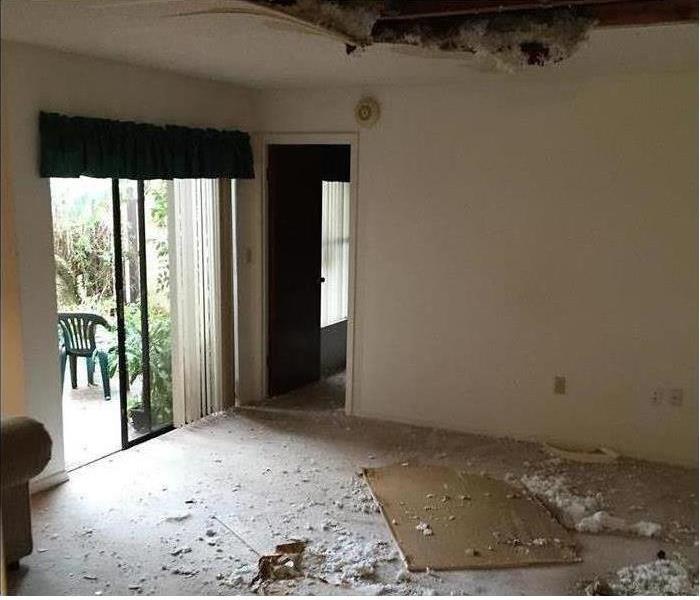 Storm damaged home in Kissimmee, FL
Storm damaged home in Kissimmee, FL
Emergency Response After Storms
Many homeowners in Kissimmee, FL, are inadequately prepared for a life-threatening storm situation. Understand the role of FEMA and other agencies in responding to a natural disaster and assessing the damage.
1. The Aftermath
The Federal Emergency Management Agency will typically send an inspector or other government official directly to the site of a flood or other disaster in order to ascertain the amount of damage and the needs of the populace. At this stage, it is helpful to be present to expedite the process. If the home is safe to enter, you can assist the FEMA official in getting a rough tally of what belongings and parts of your home structure are inundated, wind-damaged, or contaminated. Some homeowners may choose to have a complete inventory of the home as a matter of course.
2. Proof of Ownership
In a disaster situation, the federal government needs to determine the owner of the damaged property. Ensure that during a disaster or evacuation that you have access to the various deeds and titles that can prove legal ownership of your home, land, and vehicles. This will greatly expedite the process of disbursing federal aid and getting your life back on track.
3. Adjusters
After the danger of flooding is over, your insurance agency will send an adjuster to ascertain the validity of your damage claims and take a general inventory. This process is different from the type of inspection that FEMA performs to determine the severity of the disaster for the purposes of federal aid. Homeowners should be aware that public adjusters independent of any particular insurance agency also exist, and can be hired to assist with disputes over liability or coverage.
While severe storms and other natural disasters can cause significant damage and disruption, FEMA and private insurers exist to alleviate the burden and get homeowners the professional cleanup services they require.
2022 Hurricane Outlook
5/16/2022 (Permalink)
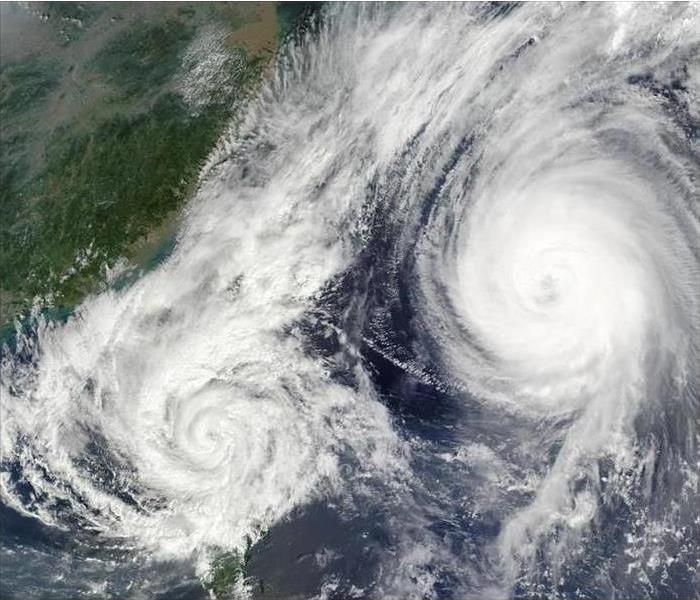 Make sure to have your hurricane preparations and disaster plans in place before June 1st!
Make sure to have your hurricane preparations and disaster plans in place before June 1st!
This Hurricane Season
The first of June is the beginning of the Atlantic hurricane season, and does not end until the last day of November.
These storms do not usually occur until the peak of the hurricane season, which is around August through October. This is because the Atlantic Ocean and El Nino’s waters are warmed from the summer months, and hurricanes first condition needed is warmer waters.
Above-Normal Season
On December 9, 2021, CSU issued an extended range forecast for the 2022 hurricane season, predicting slightly above-average activity with 13–16 named storms, 6–8 hurricanes, 2–3 major hurricanes, and an ACE index of about 124 units.
List Of 2022 Atlantic Hurricane Names:- Alex
- Bonnie
- Colin
- Danielle
- Earl
- Fiona
- Gaston
- Hermine
- Ian
- Julia
- Karl
- Lisa
- Martin
- Nicole
- Owen
- Paula
- Richard
- Shary
- Tobias
- Virginie
- Walter
How To Handle Roof Repairs After a Storm
4/11/2022 (Permalink)
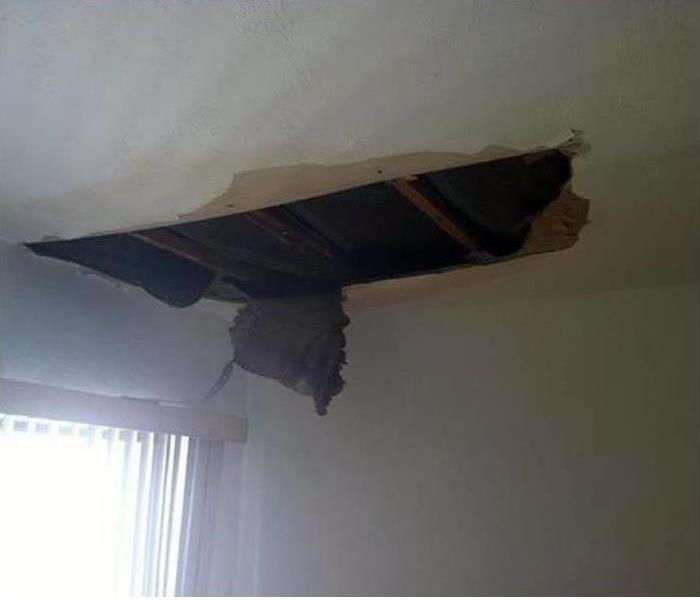 Storm damage to the roof in a Celebration, FL home
Storm damage to the roof in a Celebration, FL home
Storm damage can be stressful, and roof repair needs can top the list of post-storm concerns. Wind damage, hail and even fallen branches can leave your roof in bad shape. Whether you are waiting on a roofer or are making repairs yourself, there are a few things you should do following roof damage from a storm.
Assessing the Damage
Storms can damage your roof in many ways.
- High winds can rip off shingles and expose underlayment
- Hail can leave your roof dented and pockmarked
- Driving rain can seep under loosened shingles and cause water damage
As soon as it is safe, get a good look either from the ground or an extension ladder to gauge your roof repair needs. It helps to take pictures for insurance purposes or to know which materials to buy if you’re doing your own repairs.
Take Immediate Protective Steps
Water seeping through a roof can set the stage for serious water damage in your home and make your roof unsafe in general. A stop-gap for many Celebration, FL, homeowners is placing a waterproof tarp over the damaged area. It isn’t a substitute for permanent roof work, but it may mitigate further damage to your roof and your home’s interior.
Get an Estimate
Whether you want to pay a roofer for a roof repair or try to DIY it, it’s still a good idea to get a professional estimate. A pro may be able to help guide your own repairs or even offer a price that’s better than expected. If water has already gotten into your attic, look for a remediation company that specializes in drying building materials and restoring attics as part of your general roof restoration game plan.
From devastated shingles to pockmarked surfaces, storm damage can wreak absolute havoc on your roof. If you’re facing roof damage after a storm, let these tips guide you to the best outcome.
What To Do Until Help Arrives: When Water Damage Occurs
3/11/2022 (Permalink)
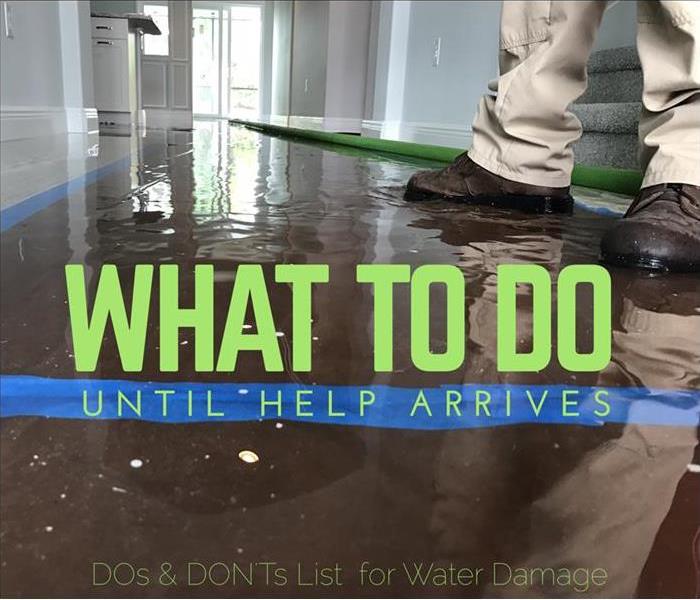 This water damage occurred during a Florida thunderstorm and was caused by heavy rainfall, which flooded the entire home.
This water damage occurred during a Florida thunderstorm and was caused by heavy rainfall, which flooded the entire home.
Central Florida has been known to be bombarded with thunderstorms for several weeks at a time. Lightning and heavy rainfall have caused many of our Florida homes extensive roof and water damages. SERVPRO of Osceola County, have seen increases of houses affected through out the summer months, and some of the damages have been catastrophic. These emergency tips will assist homeowners and their families in taking the proper actions until our professional technicians arrive. By following these Do's and Don'ts, we can help to reduce the amount of damage and increase the chances of a successful restoration.
Water Damage from Clean Water (Rain Water)
DO:
- Find the source of the water if possible and stop or block the water from entering the home.
- Turn off the circuit breakers in the wet areas of the house. Be sure the access to the power distribution panel is safe from electrical shock before doing so.
- Remove as much excess water as possible by mopping and blotting.
- Wipe excess water from wood furniture after removing lamps and tabletop items.
- Remove and prop up wet upholstery cushions for even drying.
- Place aluminum foil or wood blocks between furniture legs and wet carpeting.
- Remove to a safe, dry place any paintings, art objects, computers, documents and other materials that are valuable or sensitive to moisture.
- Use wooden clothespins to keep furniture skirts off damp floors.
- Hang draperies with coated hangers to avoid contact with wet carpeting or floors.
- Hang furs and leather goods to dry separately at room temperature.
DON’T:
- Enter rooms with standing water where electrical shock hazards may exist.
- Enter affected areas if electrical outlets, switches, circuit breakers or electrical equipment are exposed to water. Always avoid electrical shock hazards.
- Leave books, newspapers, magazines or other colored items on wet carpets or floors to cause staining.
- Leave Oriental rugs or other colored rugs on wet wall-to-wall carpets to cause staining.
- Use your household vacuum cleaner to remove water, possibly causing electrical shock or damage to the vacuum cleaner.
- Use TVs or other appliances while standing on wet carpets or floors, especially not on wet concrete floors.
- Turn off ceiling fixtures if it is wet or enter rooms where ceilings are sagging from retained water.
Preparing Your Business for Bad Weather: 3 Tips
2/10/2022 (Permalink)
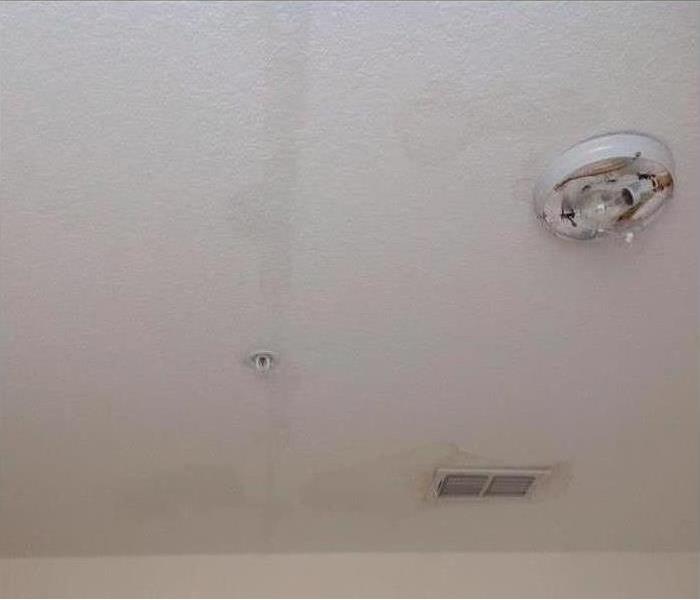 Roof leak caused by a thunderstorm in Saint Cloud, FL
Roof leak caused by a thunderstorm in Saint Cloud, FL
When freezing temperatures and storms arrive in Saint Cloud, FL, they can impact your business. Slippery roads can pose a danger for employees trying to arrive on time for their shifts, and single-digit temperatures can wreak havoc with your building’s pipes. However, there are a few ways you can protect your business, employees, and customers if a storm is in the forecast.
1. Remain Aware of Watches and Warnings
Watch the news the night before and the morning of the impending storm. If the forecast says bad weather is imminent, you may want to consider closing for the day to protect your employees. Your web designer, social media managers, and data wranglers may be able to do their jobs from home. Have your web managers announce the closure on your business’ page so your customers do not get injured trying to reach your business.
2. Insulate Exterior Pipes
If a storm is due to arrive, you may want to wrap your building’s pipes to prevent them from freezing. Frozen water can cause a pipe burst and flooding, which can cause serious damage to your building. Use rags or foam insulation on basement and exterior pipes to protect them from cold temperatures.
3. Have a Mitigation Plan in Place
If the worst should happen and your business suffers damage during bad weather, having a mitigation and restoration plan in place may help you recover faster. Contact storm damage and cleanup service before the winter season and learn about their services and how their technicians might be able to help in case of flooding or other disasters. Careful planning can mean the difference between a quick recovery and weeks of closure.
A storm in Saint Cloud, FL, can interrupt your business. However, having a bad weather plan in place can help you protect your employees and building and give you peace of mind all winter long.
#freezingtempsinflorida #coldweatherinoscelooa #frostwarnings #SERVPROofosceola
6 Tips for Preventing Storm Damage
1/24/2022 (Permalink)
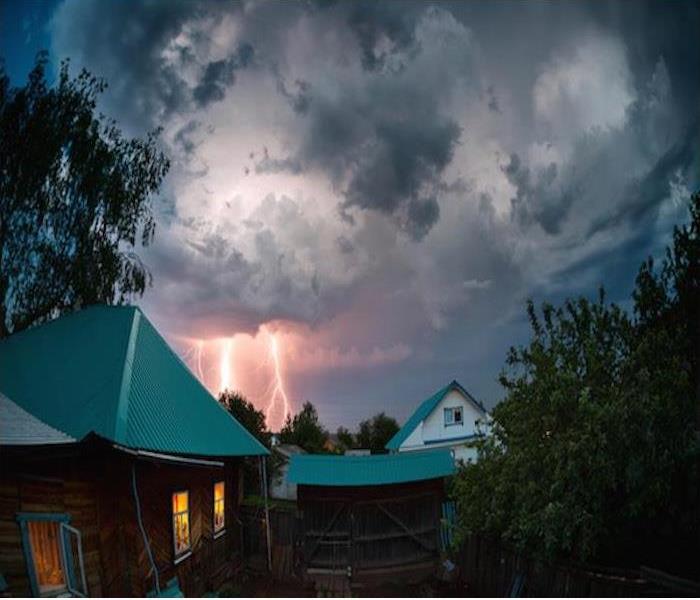 Make sure you have a plan and are prepared before any storm.
Make sure you have a plan and are prepared before any storm.
The clouds darken in the sky. The winds start to pick up. A major storm is headed your way.
If you have a major storm system headed in your direction, you need to make sure you’re prepared to avoid potential storm damage. Depending on the size of the storm, you may need to prepare for it in advance.
In Florida, the annual hurricane season means that you should always know how to prepare for a potential major storm that could hit. The following are some tips to make sure you’re prepared to limit the amount the damage to your home.
Preparation Weeks Before the Storm
If you’re in an area where major storms could hit your town, like in Florida, it’s important to keep your trees trimmed that could potentially fall on your house. Make sure any diseased branches, dead branches, or low hanging arms are removed so they won’t fall and damage your house should a storm come.
These branches can be removed at any point during the year but if you live in a climate further north that gets cold during the winter, it’s best to clip the branches during the springtime before the leaves appear. Repeat the process again in the winter when more trees are in a dormant state.
Last Minute Preparation
While much of the preparation for a major storm may have been taken care of during the days and weeks prior to the storm’s arrival such as trimming trees or putting boards over windows, there are some preparations that have to wait until the last minute.
First put your car inside of your garage and back it up to the inside door. You do this so the door won’t twist-up if the winds become too vicious. Next put bikes, children’s toys, potted plants, outside furniture, or anything that can be stored in the remaining parts of the garage. Anything that’s left outside and not nailed down needs to be stored in the garage as well. If not stored during the storm, those objects can become projectiles that could damage your home.
Make sure to tightly shut every window in the house and move away from them. During the storm it’s important to be in a room without windows so if any projectiles fly through the window, you’ll be safe. Unplug any small electrical appliances and shut down your personal computer.
During the storm, it’s important to have a battery-powered radio on hand to supply you with all the news of the storm going on outside. Find your local station that is a good source of weather information before the power goes out so you’ll just have to turn it on and be at the right station.
Lightning
If you want to be extra cautious you can purchase lightning conductor rods to install at the highest point of your house. You’ll want to make sure they’re grounded so that any direct strike will immediately be directed straight into the ground.
Moving the Movable
Make sure that you have everything that is outside either secured to the ground or brought inside. Heavy winds have the ability to pick up and throw lighter objects through the air and potentially damage your home or injure you. Larger objects like grills may be able to be left outside but you’ll want to be certain that it won’t cause damage to your home when the storm comes.
Leaks
It’s important to fix any leaks you may have around your home before the storm comes. If the storm is likely to dump a great deal of water in your area, a simple drip can turn into a flow of water and once the storm arrives, there’s nothing you can do about it. These unfixed leaks can become washouts and cause significant and costly damage to your home.
Prepare for Possible Evacuation
If the storm is bad enough, either a voluntary or mandatory evacuation could be called forcing you to vacate your home. To prepare for the possibility of an evacuation in advance, put together a small suitcase with essentials like a change of clothes and important objects like photos or anything that holds significant importance to you.
Put the suitcase somewhere it will stay safe and out of the way so you won’t trip over it. Also make sure that it’s stored somewhere that’s easy to get to so you can make a quick getaway if the time comes for you to evacuate.
If a major storm hits, follow these guidelines to help prevent potential storm damage to your home. But sometimes, regardless of how much you prepare, damage will occur. If you suffer storm damage, call on SERVPRO Of Osceola County, to come to your rescue.
Three Things You Should Know if Your Building is Damaged By Flood Water
5/24/2021 (Permalink)
During a storm in Kissimmee, FL, it is possible that your building may be damaged by flood water if the weather becomes severe. Because this is not quite the same as other water damage, you may be unsure of how to deal with it. The following is some information about this type of water that might be helpful to you.
1. Why is a Flood Different From Other Water Damage?
The reason that flood water is different from others is largely due to how it accumulates. While most water damage, such as that from leaks or broken pipes, comes from above, the water in a flood rises from the ground. As it does, it becomes category 3 water.
2. What is Category 3 Water?
When it comes to water contamination, there are three categories. Category 3 or black water, which includes water from a flood, has the highest levels of contamination. Because this water comes up from the ground, it mixes with dirt, debris and sewage. When this happens, it begins to carry waste, bacteria and harmful chemicals that can be hazardous to your health.
3. How Should You Handle It?
Because flood water is highly contaminated, it is not a good idea to try removing it on your own. Instead, you should hire a professional to thoroughly clean and sanitize the building. Any food or beverages that have been in contact with this water should be thrown away as they are no longer safe to consume. Protective gear should be worn at all times while handling category 3 water.
If your building has been affected by water or storm damage of any kind, you should have it taken care of right away to prevent it from becoming worse. If allowed to sit, moisture can contribute to mold growth and can cause materials to weaken. A professional cleanup and restoration company can sanitize the area, perform necessary repairs and salvage many affected items.
How to Prepare for Spring Storms
5/16/2021 (Permalink)
“Spring is the first kiss of summer.” -Anonymous
Spring has arrived and the excitement of summer, warm sun rays, and hot days are just around the corner. Although spring represents the end of winter and new beginnings, it also consists of spring showers, thunderstorms, and unpredictable weather, which can cause severe problems if not properly prepared. Since Florida weather already seems irregular, how do you prepare for unexpected spring storms, what do you do in the event of severe weather conditions, and what is needed to stay safe among hazardous conditions following a storm?
Preparing for the unknown can save lives, so we have provided these important preparation steps.
Organize an Emergency Plan
Putting a plan in place can potentially save you and your family’s lives. But one plan may not work for every type of severe weather condition, such as thunderstorms, floods, and tornadoes. For instance, your evacuation plan for a tornado should be different than if a flood occurred and the streets are two feet under water. Each emergency plan prepared needs to include a map of your home, routes to safety, and an emergency shelter or destination. Being prepared for each type of life-threatening weather condition is important in keeping your family safe before and after a disaster.
Go Inside When You Hear Thunder
According to the American Red Cross, lightning strikes are the leading killer. Every year lightning has killed more people than hurricanes or tornadoes. When you hear thunder, loud or soft, go inside! With lightening strikes following thunder, every lightening flash is a potential killer.
Protect Your Electronics
To avoid damaging your electronics during a storm, you should plug all electronics into surge protectors. By doing this, the surge protector protects your electronics from burning up due to voltage strikes. If any electronics are not safeguarded by surge protectors, unplug the devices before a storm.
Keep an Emergency Kit
Because severe weather can be unpredictable, you need to put together an emergency kit beforehand. When preparing an emergency kit you should include a first aid kit, a 3-5 day supply of water, nonperishable food, personal hygiene items, blankets or sleeping bags, flashlights, a battery-operated radio, and extra batteries. Make a list of important information to have on hand, like your insurance and utility company’s phone numbers. In case you get stuck in severe weather on the road, keep a second emergency kit in your car. Additional resources on an emergency kit can be found at: Ready.gov.
We at SERVPRO believe that by failing to prepare, you are preparing to fail.
Worried about flood damage affecting your building? Here’s What You Need to Know
2/26/2021 (Permalink)
What To Do When A Storm Is Headed Your Way?
Running a business in Celebration, FL, requires one to wear many hats, one of which is disaster prevention. When a storm is brewing on the horizon, what can you do to avoid or reduce flood damage from happening? Here’s a couple of tips to get you started:
Get to Know Your Local Area
Some locations are more susceptible to flooding than others, such as neighborhoods located in a valley, at the bottom of a slope or below sea level. This may seem self-explanatory and painfully obvious but you’d be surprised at how many business owners are unaware of how their location could impact their company in the event of a natural disaster. Find out if you are in a flood prone area and plan ahead.
Plan and Prepare with the Right Equipment
There are tons of modern equipment out there that are designed to minimize the impact of flood damage on your building. When in doubt, go with the tried and tested classic: the good ol’ sand bag. If you’re feeling more adventurous, there are plenty of alternatives out there that are reusable and are easier to transport. However, be sure to do your research before you commit to a purchase. Install storm shutters that are easy and quick to secure and check your electrical equipment to ensure they will be out of reach of flood waters.
Check Your Surroundings
Perhaps the most important part of avoiding storm damage is to look outside your immediate perimeter for things that may encourage floods. This means looking at street drains and storm grates and making sure that they are free of leaves and other debris that inhibit the flow of water. This is easily overlooked in the rush of preparing for an incoming storm and can have a disastrous impact on your safety.
If the weather gets the best of you, there are flood remediation experts in your state that can get your business up and running in no time. Flood damage is no joke, but if you are well prepared you can easily reduce the impact that a storm can have on your business.
Three Things About Roof Damage Mitigation
2/26/2021 (Permalink)
After a storm in Poinciana, FL, your house might have some damage that you need to take care of. In some cases, this will include roof damage. Before repairs can begin, however, the restoration company might need to do some mitigation. The following are a few things that you should know about this process.
When Do You Need Mitigation?
If you have roof damage that could become worse over time, then mitigation should be done right away. It will likely be required if you have missing shingles, cracks or holes in your roof. After an inspection has been performed, mitigation is the next step. Particularly if the damage is severe, it is important to get it done quickly.
Why Do You Need Mitigation?
The purpose of mitigation is to keep any damage to your home from getting worse. There are several things that could happen before repairs begin that could make the process even more complicated and time-consuming. Even small cracks can allow water to get inside the house, which can damage your belongings or the structure of the building. It can contribute to the growth of mold as well. Holes in the roof can allow further wind damage and can even let in small animals. Mitigation will help prevent this.
What Happens During Mitigation?
During the mitigation process, the cleanup and restoration company will cover any cracks or holes in the roof to prevent water, wind or debris from creating more problems. This is often done with a tarp, but more severe cases might require the use of wooden boards. Mitigation can sometimes include cleanup and sanitization as well.
If mitigation is not performed on the roof damage to your house, it could make the restoration process more difficult. When damage worsens, it requires more time and money to repair. Because of this, you should always have mitigation done as soon as you can.
Safeguarding Your Business From Storm Destruction
2/26/2021 (Permalink)
How to Fortify Your Building
When a major storm event such as a hurricane is barreling towards your business, time is of the essence in preparing your commercial building. Flood water from heavy rains can cause tremendous damage to an unsecured structure and force you to close your doors for weeks or months while you undergo an extensive restoration process. Protect your business in Reunion, FL, from the devastation of a storm by following a few simple guidelines to fortify your building.
Watch the weather.
One of the most important steps in preventing a flooded building is also one of the simplest – pay attention to your local weather forecasts and take any severe weather or flash flooding alerts seriously. Use the advance warning to enact preventative measures like placing sandbags around the perimeter of your business and moving expensive electronic equipment to a higher level of the building.
Design an action plan.
When a storm is about to hit, every staff member needs to have a specific role in preparing your business to withstand the destruction. Assign tasks to each team member so nobody gets overwhelmed. For example, one person should be in charge of fortifying the building to keep out flood water, another person should take care of backing up important electronic data, and someone else should supervise a final evacuation drill.
Prepare for restoration.
Even a well-prepared business can sustain water damage if a storm is especially severe. That’s why it’s a good idea to have the contact information for a reputable commercial storm damage restoration company on hand in case you need professional assistance in the cleanup and repair process. Enlisting the help of an expert means you can reopen your doors faster than if you try to manage complex reconstruction yourself.
A storm heading towards your commercial building means you need to take immediate action in preventing flood water from destroying your livelihood. By staying calm and taking steps to safeguard your building, you can ensure your business will ultimately withstand the destruction of a severe weather event.
After a storm and roof damage.
1/11/2021 (Permalink)
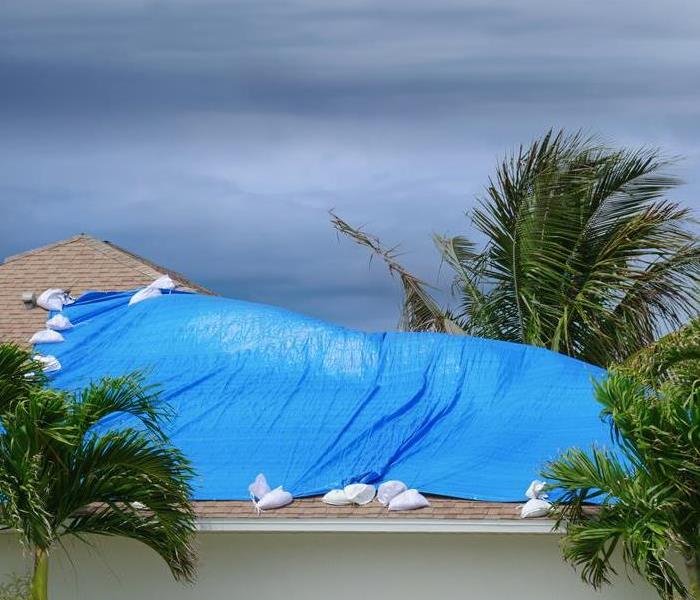 Tarp on roof
Tarp on roof
After a storm hits it is a common scene to see roofs with damage and blue tarps.
Why are that many have asked?
Most roofs do not get inspected on a yearly basis especially shingle roofs. Over time with weather elements, the shingles can start to lift or become brittle. So, when storms happen most properties that have not maintained the roof have damage.
Most property owners try to prevent more damage by placing a tarp on the affected areas. The tarps can be temporary till you get help.
How to check your roof every year prior to a storm.
1. Check your shingles
2. Make sure your gutters are clean to allow water to flow.
3. Check your siding and make sure is good and no holes are present.
4. Take photos of all the outside of your home and interior.
5. Make sure your insurance is up to date and have a copy with you.
After the storm, if you have damage.
Take photos of all the damage
Call SERVPRO of Osceola - 407-933-0707
We will work with your insurance to help you when you need us the most.
#roofdamage #SERVPROofosceola #tarponroof #whytarps #osceolastorms
5 Preparedness Tips for Flooding
5/18/2020 (Permalink)
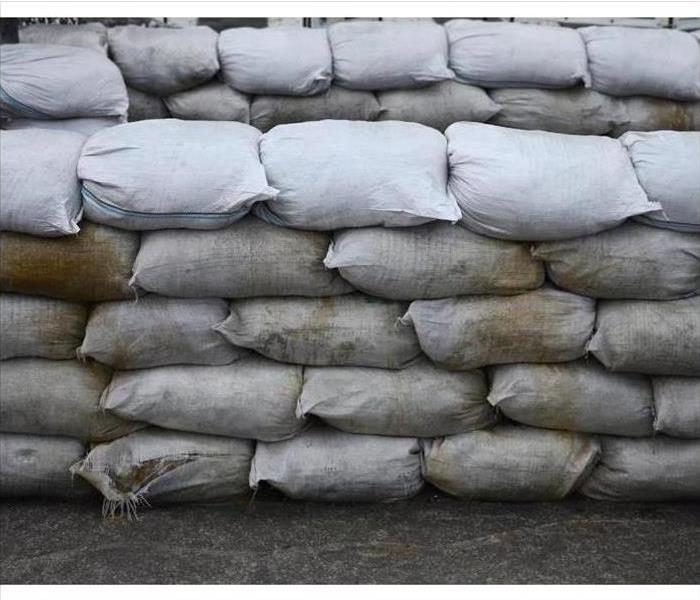 Have sandbags ready on entry points to your building
Have sandbags ready on entry points to your building
How to Prepare for the Possibility of Flooding
Storm season can certainly keep you on your toes. When you have a business in Kissimmee, FL, it’s good to know how to prepare for the possibility of flooding. Here are five tips to help you be well prepared for anything a storm may send your way.
- Have an Emergency Plan
A big part of preparing for flood damage is simply having a plan of action in place. Evacuation paths should be mapped, and those maps should be posted on every level of your building so that people know where to go in an emergency. Designate emergency responsibilities before the disaster occurs so that people know what is expected of them.
- Waterproof Your Building
Even if your building is flooded during a storm, having a solid building envelope can lower your flood cleanup costs. Have your building inspected regularly to find cracks or spots that are worn so that you can get the necessary repairs.
- Elevate Equipment and Furniture
Electrical equipment and furniture can both be damaged beyond repair during flooding. Elevate furniture, sockets, electrical panels, appliances and all wiring where floodwaters can’t get to them.
- Have Sandbags Ready
A good way to stave off excess water is to put up barriers. Set sandbags near doors, windows and other vulnerable entry points to your building. Barriers may delay the flow of water enough that you can avoid storm damage altogether.
- Update Your Insurance Coverage
It’s a smart idea to check your insurance policies periodically to make sure that all potential problems are covered. If you don’t have a policy that pays for services from storm cleanup experts, you may have to pay for a lot of damage out of pocket the next time a storm heads your way.
Flooding is a common occurrence when there is a storm in your area. By making sure your employees, your building and your insurance is adequately prepared, you can prevent a lot of damage and handle the problems that do occur with relative ease.
Maintaining Your Business's Roof for a Longer Roof Life
5/18/2020 (Permalink)
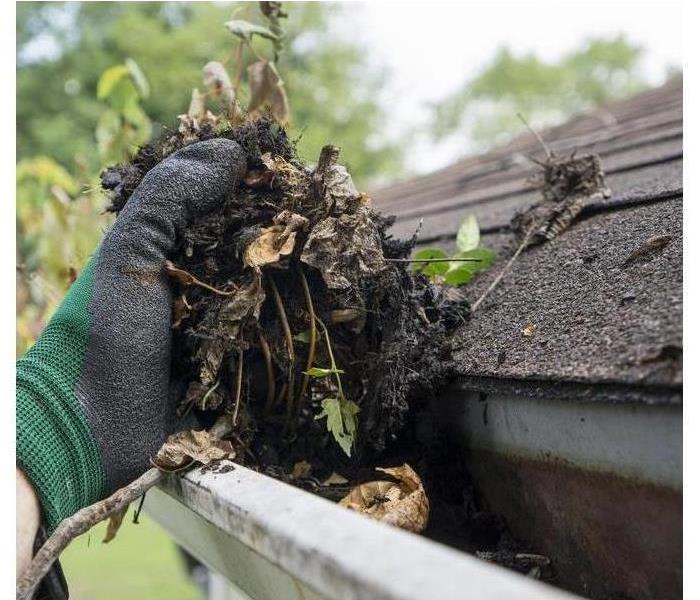 Debris blocking gutters can cause a backup of water that may lead to a roof leak
Debris blocking gutters can cause a backup of water that may lead to a roof leak
Steps to Prevent Roof Damage
You might not think much about the roof over your business, but each day it protects your assets and operations. A roof leak interrupts your business and adds unexpected expenses, so take steps now to prevent roof damage.
- Remove Debris
Roofs are designed to allow water to run off quickly during storms. Any debris on the roof can hold water, which may damage roofing materials. If you have trees nearby, make sure they are pruned away from the roof, and check after winds and in the autumn for branches and leaves that may have fallen on the roof. Check your roof regularly and after storms to ensure it is clear.
- Clean Gutters and Drains
Debris blocking gutters can cause a backup of water that may lead to a roof leak. Gutters are designed to drain water away from the roof and building, but their function is reduced when water cannot flow freely due to debris and blockages. Wind damage can also affect gutter function if a gutter becomes loose or falls. Check gutters after every storm or wind event and frequently during the autumn when leaves fall.
- Inspect for Signs of Damage
Storm conditions may cause minor roof damage that, if not addressed early, can lead to significant damage. Winter storms can be especially damaging due to the weight and expansion of ice. After a storm, in addition to clearing the roof and gutters of debris, you should also look for tears, gaps, bubbles, cracked seals, bent or gapped flashing, and missing shingles. Any of these issues can be a small repair if caught early rather than a major repair or roof replacement if left to worsen. As a business owner or manager, you'll want to call a storm cleanup professional in Kissimmee, FL, to inspect your business's roof.
Protect your business and avoid unexpected expenses by monitoring the health of its roof. Keep your roof and gutters clear and inspect them regularly for signs of damage in order to avoid issues that can lead to a roof leak.
Is Your Business Ready To Withstand a Flood?
2/18/2020 (Permalink)
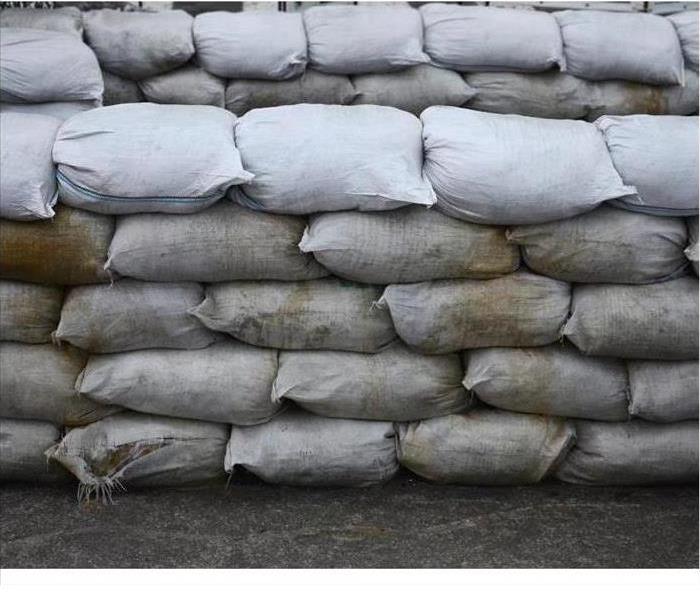 Sandbags are one of the most effective ways to protect your commercial building in Reunion,FL
Sandbags are one of the most effective ways to protect your commercial building in Reunion,FL
Is Your Business Ready To Withstand a Flood?
Heavy precipitation moving towards your area can be one of the biggest hazards to your business. Severe rainstorms bring the threat of flash flooding that can destroy your building. That’s why it’s so important to prepare your business in Reunion, FL, to withstand the potential dangers of a sudden flood. By keeping a few simple guidelines in mind, you can make sure your doors reopen again quickly after a heavy rain event.
1. Prepare a flood plan. The best time to design and enact an emergency flood evacuation plan is well before a dangerous weather event is looming. Work with your employees to devise an escape route that will allow everyone in the building to exit quickly if waters are rising. Make sure you review the evacuation plan periodically with your staff to ensure that everyone is comfortable directing customers to safety.
2. Protect your equipment. Flood damage to expensive electronics like computers, copiers, and fax machines can bring your business to a standstill while you undergo a lengthy insurance claims process. Avoid this nightmare by moving valuable items to a higher level of the building until the flooding threat is over.
3. Reinforce your perimeter. Sandbags are one of the most effective ways to protect your business from storm damage. Placing them around entryways like doors and windows where water can enter is vital to avoiding serious flood problems. However, even the most well- prepared commercial building can be devastated by the effects of a major weather event. If your business sustains severe water damage you should contact a certified restoration professional immediately to begin the cleanup process.
A flooding event can pose serious consequences to your business if proper precautions aren’t taken. By implementing a few preparation procedures well in advance of a major weather event, you can protect your business from the dangers of an intense unexpected storm.
What Should I Do When My Property in Kissimmee Is Affected By Water Damage?
2/18/2020 (Permalink)
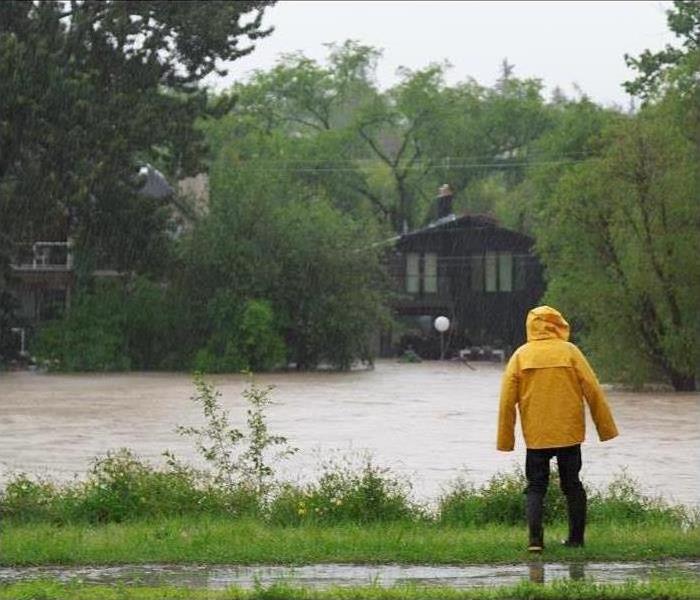 Excess River Water Threatens Flooding in Kissimmee Homes
Excess River Water Threatens Flooding in Kissimmee Homes
SERVPRO®: Restoring Your Kissimmee Home After Water Damage
Water damage in your Kissimmee home can be stressful, but taking immediate action is the key to minimizing the impact. When water infiltrates your property, it can quickly seep into structural elements, potentially causing extensive damage and fostering mold and mildew growth. Acting swiftly not only saves you time and money but also helps protect your cherished belongings.
At SERVPRO, we specialize in water damage restoration, offering a fast and reliable solution to get your home back to normal. Here's why addressing water damage promptly—and calling in the experts—matters:
Understanding Water Damage
Water damage can occur for a variety of reasons, from natural disasters like floods, hurricanes, or storms to household issues such as burst pipes or leaky appliances. Beyond visible damage, water intrusion can lead to:
- Poor air quality
- Mold and mildew growth
- High humidity levels
- Unpleasant odors that linger in walls, floors, and ceilings
- Damage to furniture, electronics, artwork, and personal possessions
To protect your home and belongings, it’s critical to start the water removal and cleanup process immediately. SERVPRO’s team is here to help.
Why Choose SERVPRO for Water Damage Restoration?
When water damage strikes, you need experienced professionals on your side. Here’s how SERVPRO can make a difference:
- Comprehensive Assessment: Our team conducts a thorough inspection to identify the extent of the damage, creating a customized restoration plan tailored to your needs.
- Rapid Response: SERVPRO’s specialists are ready to act quickly, deploying the resources needed to restore your property as fast as possible.
- Advanced Equipment: We use industry-leading tools like high-powered pumps, vacuums, air movers, and dehumidifiers to ensure every trace of moisture is eliminated.
The Drying Process: Essential for Restoration
After standing water is removed, proper drying is crucial to prevent further damage. With SERVPRO’s advanced equipment and techniques, we work to preserve your property by:
- Minimizing the need to replace hardwood floors, carpets, or walls.
- Preventing stains and odors caused by mold and mildew.
- Restoring your home to its pre-damage condition.
Acting quickly not only ensures a smoother restoration process but also minimizes long-term damage.
We’re Here When You Need Us Most
The moment water damage occurs, your first call should be to your insurance company—your second, to SERVPRO. Our highly trained team is available 24/7, providing emergency services to help restore your Kissimmee home “Like it never even happened.”
Locally Owned, Nationally Backed
SERVPRO of Osceola County is proud to be part of the Kissimmee community. As a locally owned and operated business, we understand the unique challenges our neighbors face and are committed to providing exceptional service.
We proudly serve Kissimmee, Osceola, and the surrounding areas. When you experience a water emergency, we’re just a phone call away.
Call Us Now for Fast, Reliable Water Damage Restoration
We’ll be at your door within an hour of your emergency. Don’t wait—call SERVPRO today.
According to SERVPRO, these are recommendations on what to do before a storm approaches
12/6/2019 (Permalink)
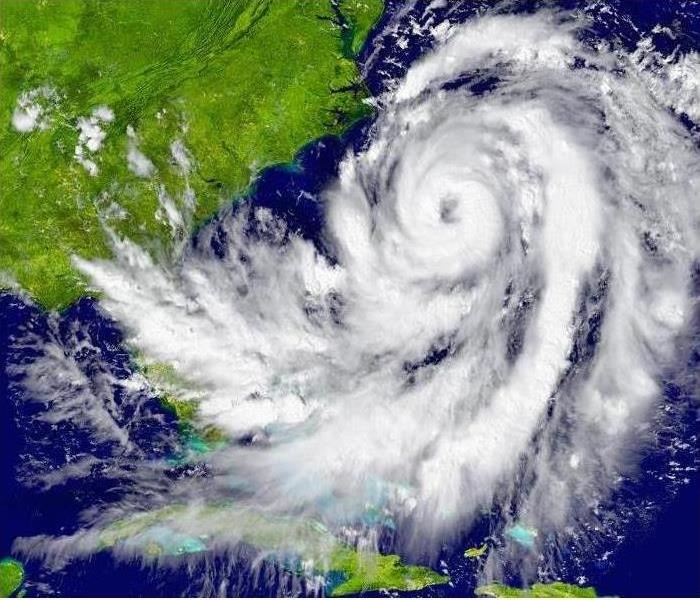 Storm and flood damage require specialized restoration techniques and equipment.
Storm and flood damage require specialized restoration techniques and equipment.
The experts at SERVPRO have issued the following guidelines on what homeowners and property managers can do to protect themselves BEFORE Kissimmee Storm Damage occurs:
- Use wooden beams to reinforce garage doors.
- In a clean bathtub, open the cold water spigot and fill until the maximum possible level. This can provide you vital drinking water for days in an emergency.
- Take the car to the nearest station and fill up the tank with fuel.
- Rehearse your storm evacuation plan with your family, and make sure that every family member knows multiple alternate routes to safety in case you get split up.
- Head towards the nearest shelter in case you need to leave your home quickly.
- Board up your windows and doors with 5/8-inch plywood or use tailored hurricane shutters.
- Scour the outside of your property and pick up any items that could be lifted by the wind and hurled through windows or cause other Kissimmee storm damage.
- Get your axe and take it to the attic. In case of severe flooding, you may need to break your way out through the roof.
- Locate important personal documents such as wills, passports, birth certificates and Social Security cards, and store all of them in a secure, sealed, watertight container.
- Obtain your pre-written inventory of all valuable household appliances, electronics, items, jewelry and property.
- Evacuate your home immediately, if ordered to do so, and follow all commands.
- If you are forced to flee your home, be sure to leave a note that says where you are planning to go.
We proudly serve:
Kissimmee, FL
Saint Cloud, FL
Celebration, FL
What should you have on hand during a storm?
12/6/2019 (Permalink)
The experts at SERVPRO recommend having the following supplies on hand to successfully avoid storm damages:
- At least a three-day supply of clean drinking water, being sure to store enough to provide at least one gallon, per person, per day.
- At least a three-day supply of food. Durable, non-perishable items are ideal, such as: canned meat and meat products, canned vegetables, canned juice, and canned fruits. Other high-calorie foods such as peanut butter, jelly and crackers are also recommended. Other excellent choices are: trail mix, nuts, granola, energy bars, cookies, cereal and other comfort foods.
- A functioning can opener.
- One or more flashlights, particularly the kind that do not require batteries.
- A battery-powered radio, ideally one that can receive urgent broadcasts on the weather band.
Locally Owned Company with National Storm Resources
We live and work in this community too; we might even be neighbors. As a locally owned and operated business, SERVPRO of Osceola County is close by and ready to respond to storm and disaster events. We are proud to be an active member of the Kissimmee community and want to do our part to make our community the best it can be.
4 Ways You Can Prepare Your Business for a Winter Storm
10/24/2019 (Permalink)
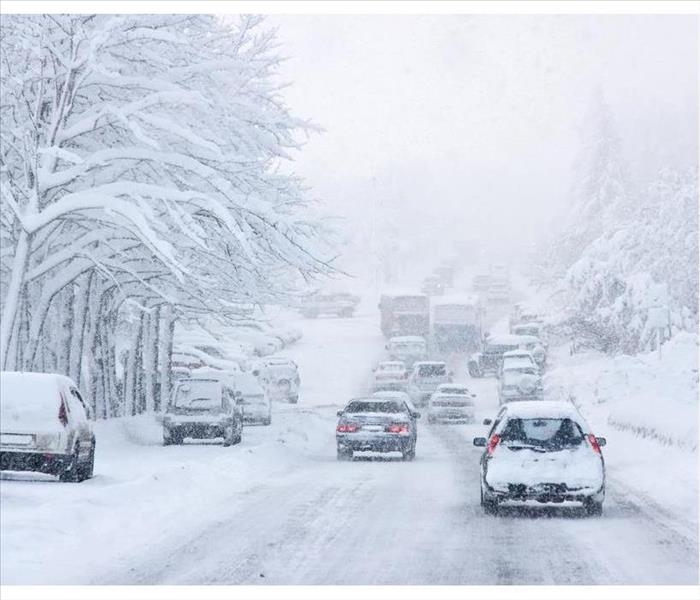 A winter storm can be dangerous, you should always have a plan for severe weather
A winter storm can be dangerous, you should always have a plan for severe weather
4 Ways You Can Prepare Your Business for a Winter Storm
If you are expecting a winter storm in Lokosee, FL, then you should start taking steps to ensure the safety of your company and your employees. This kind of storm can cause damage to your building and can pose some safety hazards as well. The following tips can be helpful in this situation.
1. Watch the News
Anytime you’re expecting severe weather, it is a good idea to keep an eye on the news so that you can stay prepared in case of an emergency. Watch for changes in the forecast and pay careful attention to any upcoming storms.
2. Check Windows and Doors
During severe weather, windows and doors should be inspected to prevent storm damage. If they don’t seal properly, they can let in moisture that can affect the building. Leaks can cause materials to weaken, rot or warp. It can also contribute to the growth and spread of mold which can be difficult to remove.
3. Keep the Building Warm
If the temperature drops during the storm, it is possible that you could end up with a pipe break. If this happens, it can flood the building and cause a lot of damage. Keeping the building warm, even after work hours, is one way to prevent your pipes from freezing and breaking.
4. Have an Emergency Plan
Because a winter storm can be dangerous, you should always have a plan for severe weather. Make sure your employees know your policies and what is expected of them. You may want to plan for them to work from home if conditions become unsafe for travel.
While there are steps you can take to prevent your building from being damaged during a winter storm, this weather can be unpredictable, and you cannot plan for everything. If your building is affected by winds or water during severe weather, a cleanup and restoration service can perform necessary repairs to restore the building and your belongings.
6 Sump Pump Maintenance Tips for a Functional Home
9/12/2019 (Permalink)
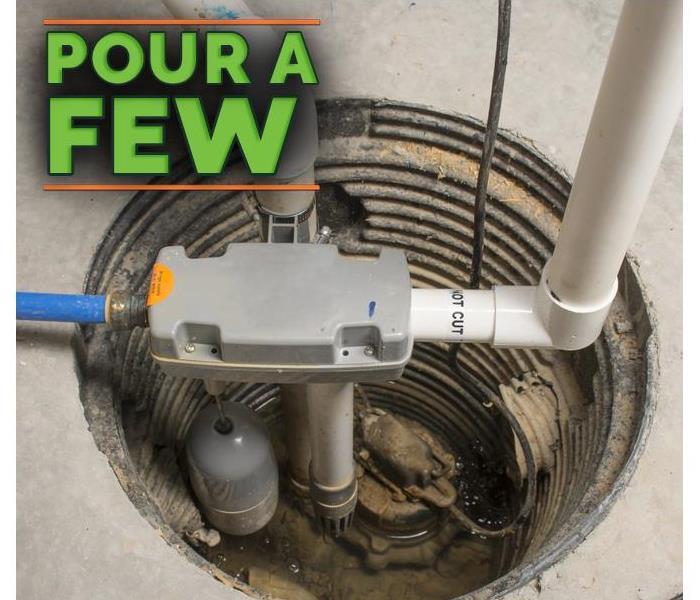 Pour water into your basin to ensure that it drains quickly
Pour water into your basin to ensure that it drains quickly
A sump pump moves accumulated water away from your basement to prevent interior damage and floods. Unfortunately, too many homeowners ignore this important appliance until it’s too late. These six easy and fast maintenance tips can help keep your living space in top condition.
1. Look at the Connecting Cords
Causes of an overflow include:
- Power outages
- Clogs
- Freezes
- Overwhelm
Rather than struggling with the complex components of your appliance, you can simply check the cord running from your unit to the working ground fault circuit interrupter. Make sure it’s plugged in properly and that there are no kinks.
2. Remove Debris
Debris may build up on the intake screen of your unit and impact its performance. Carefully inspect and clean the screen at least once a year.
3. Test Your Unit
Pour water into your basin to ensure that it drains quickly. It’s a prudent thing to do before a rainy or snowy season. If you notice slow drainage, then contact residential storm experts who can complete a more thorough inspection.
4. Replace Your Battery
If your sump pump contains a battery, it needs to be replaced every two or three years. Follow the instructions in the manufacturer’s guide to complete a safe battery swap.
5. Clean the Discharge Pump and Vent Hole
Pump maintenance in Reunion, FL, isn’t always pretty, but it’s necessary. Dirt, gravel and debris around the discharge pump or vent hole of your unit cause it to work harder to drain water, thus increasing the possibility of overflowing. Roll up your sleeves and clear any obstructions once a year so your unit can work properly.
6. Inspect the Pit and Float Component
Debris can also gather in the pit of your pump, so remember to check this area as well. Keep the perimeter of the float component unobstructed.
Water damage to your basement can be expensive to repair. Follow these maintenance tips to keep your sump pump operating at peak capacity.

 24/7 Emergency Service
24/7 Emergency Service


















